Geocultural Interactions in Minoan Crete: An Environmental Education Perspective through Drama Techniques
Abstract
1. Introduction
2. Literature Review
2.1. Minoan Civilization and Geocultural Legacy
2.2. Enhancing Environmental and Historical Awareness through Theatre
3. Study Area
4. Methodology—Environmental Education Curriculum Development
5. Results
6. Discussion
6.1. Interplay between Archaeological Legacy, Sustainable Tourism, and Experiential Engagement
6.2. Key Elements Driving the Success of Environmental Education Program
7. Conclusions
Author Contributions
Funding
Informed Consent Statement
Data Availability Statement
Acknowledgments
Conflicts of Interest
References
- Reynard, E.; Giusti, C. The landscape and the cultural value of geoheritage. In Geoheritage; Assessment, Protection, and Management; Reynard, E., Brilha, J., Eds.; Elsevier: Amsterdam, The Netherlands, 2018; pp. 147–165. [Google Scholar]
- Santangelo, N.; Valente, E. Geoheritage and Geotourism Resources. Resources 2020, 9, 80. [Google Scholar] [CrossRef]
- Zafeiropoulos, G.; Drinia, H.; Antonarakou, A.; Zouros, N. From Geoheritage to Geoeducation, Geoethics and Geotourism: A Critical Evaluation of the Greek Region. Geosciences 2021, 11, 381. [Google Scholar] [CrossRef]
- Gordon, J.E. Geoheritage, Geotourism and the Cultural Landscape: Enhancing the Visitor Experience and Promoting Geoconservation. Geosciences 2018, 8, 136. [Google Scholar] [CrossRef]
- Pijet-Migoń, E.; Migoń, P. Geoheritage and Cultural Heritage—A Review of Recurrent and Interlinked Themes. Geosciences 2022, 12, 98. [Google Scholar] [CrossRef]
- Tsipra, T.; Drinia, H. Geocultural Landscape and Sustainable Development at Apano Meria in Syros Island, Central Aegean Sea, Greece: An Ecomuseological Approach for the Promotion of Geological Heritage. Heritage 2022, 5, 113. [Google Scholar] [CrossRef]
- Scarlett, J.P.; Riede, F. The Dark Geocultural Heritage of Volcanoes: Combining Cultural and Geoheritage Perspectives for Mutual Benefit. Geoheritage 2019, 11, 1705–1721. [Google Scholar] [CrossRef]
- Tzatzanis, M.; Wrbka, T.; Sauberer, N. Landscape and vegetation responses to human impact in sandy coasts of Western Crete, Greece. J. Nat. Conserv. 2003, 11, 187–195. [Google Scholar] [CrossRef]
- Vogiatzakis, I.; Rackham, O. Crete. In Mediterranean Island Landscapes; Landscape Series; Springer: Dordrecht, The Netherlands, 2008; Chapter 11; Volume 9, pp. 245–270. [Google Scholar]
- Chlouveraki, S.; Stefanis, A.; Helvaci, Y.Z.; Zervaki, K.; Theoulakis, P. Rapid Condition Surveys of Archaeological Excavations: Training Professionals in Two Minoan Sites on East Crete, Greece. Heritage 2019, 2, 90. [Google Scholar] [CrossRef]
- Alexandrakis, G.; Manasakis, C.; Kampanis, N.A. Economic and Societal Impacts on Cultural Heritage Sites, Resulting from Natural Effects and Climate Change. Heritage 2019, 2, 19. [Google Scholar] [CrossRef]
- Lyrintzis, A.G.; Angelakis, A.N. 2006 Is the Labyrinth a Water Catchment Technique? People and Water Management in Minoan Crete. In Proceedings of the 1st IWA International Symposium on Water and Wastewater Technologies in Ancient Civilizations, Iraklio, Greece, 28–30 October 2006; pp. 163–174. [Google Scholar]
- Angelakis, A.N.; Dialynas, M.G.; Despotakis, V. Evolution of Water Supply Technologies in Crete, Greece through the Centuries. In Evolution of Water Supply through the Millennia; Angelakis, A.N., Mays, L.W., Koutsoyiannis, D., Mamassis, N., Eds.; IWA Publishing: London, UK, 2012; pp. 227–258. [Google Scholar]
- Angelakis, A.N.; Mays, L.W.; Koutsoyiannis, D.; Mamassis, N. (Eds.) Evolution of Water Supply Throughout Millennia; IWA Publishing: London, UK, 2012; pp. xxii, 560. [Google Scholar]
- Angelakis, A.N.; Spyridakis, S.V. The status of water resources in Minoan times: A preliminary study. In Diachronic Climatic Impacts on Water Resources with Emphasis on Mediterranean Region, 1st ed.; Angelakis, A.N., Issar, A., Eds.; Springer: Heidelberg, Germany, 1996; pp. 161–191. [Google Scholar]
- Fassoulas, C.; Panagiotaκis, Ν. Could the rise and development of past civilizations depend on the geological environment? In Νatural and Cultural Landscapes: The Geological Foundation; Parkes, M.A., Ed.; Royal Irish Academy: Dublin, Ireland, 2004; pp. 147–151. [Google Scholar]
- Fassoulas, C.; Kritsotakis, M. Geology, Geomorphology, History and Recent Status of Water Resources of the Pediada, Crete, Greece. In Proceedings of the IWA 1st International Symposium on Water and Wastewater Technologies in Ancient Civilizations, Iraklio, Greece, 28–30 October 2006; pp. 231–238. [Google Scholar]
- Mariolakos, I. The Forgotten Geographical and Natural-Oceanographic Knowledge of the Prehistoric Greeks. (In Greek). Available online: http://www.ekke.gr/estia/Cooper/Mariolakos/New_Mariolakos_greek.pdf (accessed on 20 October 2023).
- Hatzigiannakis, K.; Melessanaki, K.; Philippidis, A.; Kokkinaki, O.; Kalokairinou, E.; Siozos, P.; Pouli, P.; Politaki, E.; Psaroudaki, A.; Dokoumetzidis, A.; et al. Monitoring and Mapping of Deterioration Products on Cultural Heritage Monuments Using Imaging and Laser Spectroscopy. Commun. Comput. Inf. Sci. 2019, 962, 419–429. [Google Scholar]
- Hood, S.; Smyth, D. Archaeological survey of the Knossos Area. Br. Sch. Athens Suppl. Vol. 1981, 14, 1–69. [Google Scholar]
- Hughey, J.R.; Paschou, P.; Drineas, P.; Mastropaolo, D.; Lotakis, D.M.; Navas, P.A.; Michalodimitrakis, M.; Stamatoyannopoulos, J.A. A European population in Minoan Bronze Age Crete. Nat. Commun. 2013, 4, 1861. [Google Scholar] [CrossRef] [PubMed]
- Betancourt, P.P. Land Use on the Chrysokamino Farmstead. Hesperia Suppl. 2006, 36, 241–256. [Google Scholar]
- Kaniewski, D.; Paulissen, E.; Van Campo, E.; Al-Maqdissi, M.; Bretschneider, J.; Van Lerberghe, K. Middle East coastal ecosystem response to middle-to-late Holocene abrupt climate changes. Proc. Natl. Acad. Sci. USA 2008, 105, 13941–13946. [Google Scholar] [CrossRef] [PubMed]
- Fiorentino, G.; Caracuta, V.; Calcagnile, L.; D’Elia, M.; Matthiae, P.; Mavelli, F.; Quarta, G. Third millennium BC climate change in Syria highlighted by carbon stable isotope analysis of 14C-AMS dated plant remains from Ebla. Palaeogeogr. Palaeoclimatol. Palaeoecol. 2008, 266, 51–58. [Google Scholar] [CrossRef]
- Moody, J. Environmental Change and Minoan Sacred Landscapes. Hesperia Suppl. 2009, 42, 241–249. [Google Scholar]
- Rackman, O.; Moody, J. The Making of Crean Landscape; Manchester University Press: Manchester, UK, 1996; p. 237. [Google Scholar]
- Mourtzas, N.; Kolaiti, E. Palaeogeography of Ancient Lasaia (SE Crete, Greece) the Evolution of a Harbour from the Minoan Palatial Period to Roman Times. Méditerranée, Paleoenvironment, Geoarchaeology, Historical Geography. 2021. Available online: https://journals.openedition.org/mediterranee/12549 (accessed on 15 October 2023).
- Mourtzas, N.D.; Kolaiti, E.; Anzidei, M. Vertical land movements and sea level changes along the coast of Crete (Greece) since Late Holocene. Quat. Int. 2016, 401, 43–70. [Google Scholar] [CrossRef]
- Fytrolakis, N.; Peterek, A.; Schroder, B. Initial geoarchaeologic invastigations on the Holocene coastal configaration near Phaistos/Agia Triada(Messara plain, central Crete, Greece). Z. Geomorphol. Suppl. 2005, 137, 111–123. [Google Scholar]
- Ghilardi, M.; Psomiadis, D.; Andrieu-Ponel, V.; Colleu, M.; Sotiropoulos, P.; Longo, F.; Rossi, A.; Amato, V.; Gasse, F.; Sinibaldi, L.; et al. First evidence of a lake at Ancient Phaistos (Messara Plain, South-Central Crete, Greece): Reconstructing paleoenvironments and differentiating the roles of human land-use and paleoclimate from Minoan to Roman times. Holocene 2018, 28, 1225–1244. [Google Scholar] [CrossRef]
- Spyridakis, M. Uncharted Mythological Messara. From the Myth of the abduction of Europe till present. Holy Metropolis of Gortyna and Arcadia. In Proceedings of the 2nd International Conference of Gortynas, Greece, Moires, Greece, 19–21 September 2014; pp. 141–154. [Google Scholar]
- Spyridakis, Μ. Ports of the Messara Plain. From the First Port of Antiquity to Nowadays and the Issue of the Myth of the of Europa, Archaeological Work in Crete; University of Crete—Department of History and Archaeology—Ministry of Culture and Sports—Ephorate of Antiquities of Rethymno: Rethymnon, Greece, 2013; pp. 329–345. [Google Scholar]
- Angelakis, A.N. Hydro-technologies in the Minoan Era. Water Supply 2017, 17, 1106–1120. [Google Scholar] [CrossRef]
- Rapp, G. Archaeomineralogy; Springer Science & Business Media: Berlin, Germany, 2009. [Google Scholar]
- Hatzaki, E. Knossos, the Little Palace; The British School at Athens: Athens, Greece, 2005. [Google Scholar]
- Koepke, J.; Seidel, E.; Kreuzer, H. Ophiolites on the Southern Aegean islands Crete, Karpathos and Rhodes: Composition, geochronology and position within the ophiolite belts of the Eastern Mediterranean. Lithos 2002, 65, 183–203. [Google Scholar] [CrossRef]
- Tortorici, L.; Catalano, S.; Cirrincione, R.; Tortorici, G. The Cretan ophiolite-bearing mélange (Greece): A remnant of Alpine accretionary wedge. Tectonophysics 2012, 568, 320–334. [Google Scholar] [CrossRef]
- Warren, P. Minoan Stone Vases; Cambridge University Press: Cambridge, UK, 1969. [Google Scholar]
- Palmer, J.A. Environmental Education in the 21st Century. Theory, Practice, Progress and Promise; Routledge: London, UK, 1998. [Google Scholar]
- Wolff, L. Nature and Sustainability. An Educational Study with Rousseau and Foucault; Diss. Saarbrücken; LAP Lambert Academic Publishing: Saarbrücken, Germany, 2011. [Google Scholar]
- Sureda Negre, J.; Calvo Sastre, A. Environmental education. In Sustainable Development and Intercultural Sensitivity; New Approaches for a Better World; Miranda, B., Alexandre, F., Ferreira, M., Eds.; Universidade Aberta: Lisbon, Portugal, 2004; pp. 33–40. [Google Scholar]
- Fiandrino, S.; Scarpa, F.; Torelli, R. Fostering Social Impact Through Corporate Implementation of the SDGs: Transformative Mechanisms Towards Interconnectedness and Inclusiveness. J. Bus. Ethics. 2022, 180, 959–973. [Google Scholar] [CrossRef]
- Mariani, L.; Trivellato, B.; Martini, M.; Marafioti, E. Achieving Sustainable Development Goals through Collaborative Innovation: Evidence from Four European Initiatives. J. Bus. Ethics. 2022, 180, 1075–1095. [Google Scholar] [CrossRef] [PubMed]
- Calabrezou, A. Dramatic Art in Education as a Means of Cultivating Preschool Children’s Attitudes towards Environmental Protection. An Action Research in the 4th Grade of 2nd Primary School of Pyrgos. Ph.D. Thesis, University of Pelopponnese, School of Arts, Nafplion, Greece, 2018. [Google Scholar]
- McNaughton, M.J. Educational drama in the teaching of education for sustainability. Environ. Educ. Res. 2004, 10, 139–155. [Google Scholar] [CrossRef]
- McNaughton, M.J. Learning from participants’ responses in educational drama in the teaching of Education for Sustainable Development. Res. Drama Educ. 2006, 11, 19–41. [Google Scholar] [CrossRef]
- McNaughton, M.J. Educational drama in education for sustainable development: Ecopedagogy in action. Ped. Cult. Soc. 2010, 18, 289–308. [Google Scholar] [CrossRef]
- McNaughton, M.J. We know how they feel: Global storylines as transformative, pedagogical learning. In Learning for Sustainability in Times of Accelerating Change; Wals, A.E., Corcoran, P.B., Eds.; Wageninger Academic Publishers: Wageninger, The Netherlands, 2013; pp. 457–476. [Google Scholar]
- McNaughton, M.J. From acting to action: Developing global citizenship through global storylines drama. J. Environ. Educ. 2014, 45, 16–36. [Google Scholar] [CrossRef]
- Fien, J.; Tilbury, D. The Global Challenge of Sustainability. In Education and Sustainability: Responding to the Global Challenge; Tilbury, D., Stevenson, R., Fien, J., Schreuder, D., Eds.; IUCN: Cambridge, UK, 2002. [Google Scholar]
- Perdikari, S.; Skanavis, C.; Kontoyianni, A. Research and study of the “Environmental Characteristics” of Pre-school Education Teachers. Mod. Educ. 2005, 141, 156–175. (In Greek) [Google Scholar]
- Alkistis. White Cow—Black Cow. In Dramatic Art in Education and Interculturalism; Topos: Athens, Greece, 2008. [Google Scholar]
- Kagan, S.; Kirchberg, V. (Eds.) Sustainability: A New Frontier for the Arts and Cultures; Verlag für Akademische Schriften: Waldkirchen, Germany, 2008. [Google Scholar]
- Curtis, J.D.; Howden, M.; Curtis, F.; McColm, I.; Scrine, J.; Blomfield, T.; Reeve, I.; Ryan, T. Drama and Environment: Joining Forces to Engage Children and Young People in Environmental Education. Aust. J. Environ. Educ. 2013, 29, 182–201. [Google Scholar] [CrossRef]
- Bailey, S.; Watson, R. Establishing basic ecological understanding in younger pupils: A pilot evaluation of a strategy based on drama/role play. Int. J. Sci. Educ. 1998, 20, 139–152. [Google Scholar] [CrossRef]
- Herbst, J.-H. Current and Future Potentials of Liberation Pedagogies: A Discussion of Paulo Freire’s, Augusto Boal’s, and Johannes, A. van der Ven’s Approaches. Religions 2023, 14, 145. [Google Scholar] [CrossRef]
- MacDonald, S.; Rachel, D. Augusto Boal’s Forum Theatre for Teachers. Educ. Theatre 2001, 1, 42–49, Hellenic Network for Theatre in Education. [Google Scholar]
- Kosti, K.; Papaioannou, T. Drama in Education for Critical Historical Thinkers: A Case Study in the Greek Context. Cenario J. Performative Teach. Learn. Res. 2021, XIV, 26–41. [Google Scholar] [CrossRef]
- Kontogianni, A. Dramatic Art in Education, Field; EllinikaGrammata: Athens, Greece, 2012. [Google Scholar]
- Fassoulas, C. The structural evolution of central Crete: Insight into the tectonic evolution of the South Aegean (Greece). J. Geodynamics 1999, 27, 23–43. [Google Scholar] [CrossRef]
- Caputo, R.; Catalano, S.; Monaco, C.; Romagnoli, G. Middle-late quaternary geodynamics of Crete, southern Aegean, and seismotectonic implications. Bull. Geol. Soc. Greece 2010, 43, 400–408. [Google Scholar] [CrossRef]
- Fassoulas, C. Promoting local heritage and products with modern technology in Psiloritis UGGp, Crete, Greece. In Proceedings of the 7th Asian Pacific Geopark Network International Meeting, Songkhla, Thailand, 4–11 September 2022. [Google Scholar]
- Strobl, M.; Hetzel, R.; Fassoulas, C.; Kubik, P.W. A long-term rock uplift rate for eastern Crete and geodynamic implications for the Hellenic subduction zone. J. Geodyn. 2014, 78, 21–31. [Google Scholar] [CrossRef]
- Meulenkamp, J.; Jonkers, A.; Spaak, P.P. Late Miocene to early Pliocene development of Crete. In Proceedings of the VI Colloquium Geology of the Aegean Region, Athens, Greece, 1977; pp. 137–149. [Google Scholar]
- Meulenkamp, J.E.; van der Zwaan, G.J.; van Wamel, W.A. On Late Miocene to Recent Vertical Motions in the Cretan Segment of the Hellenic Arc. Tectonophysics 1994, 234, 53–72. [Google Scholar] [CrossRef]
- Roberts, G.G.; White, N.J.; Shaw, B. An uplift history of Crete, Greece, from inverse modeling of longitudinal river profiles. Geomorphology 2013, 198, 177–188. [Google Scholar] [CrossRef]
- Dermitzakis, M.; Papanikolaou, D. Paleogeography and geodynamics of the Aegean region during Neogene. Ann. Geol. Pays Hell. 1981, 4, 245–289. [Google Scholar]
- Angelier, J.; Lybéris, N.; Le Pichon, X.; Barrier, E.; Huchon, P. The Tectonic Development of the Hellenic Arc and the Sea of Crete: A Synthesis. Tectonophysics 1982, 86, 159–163. [Google Scholar] [CrossRef]
- Mourtzas, N.D. Archaeological indicators for sea level change and coastal neotectonic deformation: The submerged Roman fish tanks of the gulf of Matala, Crete, Greece. J. Archaeol. Sci. 2012, 39, 884–895. [Google Scholar] [CrossRef]
- Mouslopoulou, V.; Moraetis, D.; Benedetti, L.; Guillou, V.; Bellier, O.; Hristopulos, D. Normal faulting in the forearc of the Hellenic subduction margin: Paleoearthquake history and kinematics of the Spili Fault, Crete, Greece. J. Struct. Geol. 2014, 66, 298–308. [Google Scholar] [CrossRef]
- Mourtzas, N.D. Fish tanks of eastern Crete (Greece) as indicators of the Roman sea level. J. Archaeol. Sci. 2012, 39, 2392–2408. [Google Scholar] [CrossRef]
- Nicol, A.; Mouslopoulou, V.; Begg, J.; Oncken, O. Displacement accumulation and sampling of paleoearthquakes on active normal faults of Crete in the eastern Mediterranean. Geochem. Geophys. Geosystems 2020, 21, e2020GC009265. [Google Scholar] [CrossRef]
- Fassoulas, C. The Tectonic Development of a Neogene Basin at the Leading Edge of the Active European Margin: The Heraklion Basin, Crete, Greece. J. Geodyn. 2001, 31, 49–70. [Google Scholar] [CrossRef]
- Papadopoulos, G.A. Εarthquake sources and seismotectonics in the area of Crete. In Minoan Earthquakes-Breaking the Myth through Interdisciplinarity, 1st ed.; Jusseret, S., Sintubin, M., Eds.; Leuven University Press: Leuven, Belgium, 2017; pp. 165–190. [Google Scholar]
- Sintubin, M.; Jusseret, S.; Driessen, J. Reassessing ancient earthquakes on Minoan Crete: Getting rid of catastrophism. In Earthquake Geology and Archaeology: Science, Society and Critical Facilities, Proceedings of the 2nd INQUAIGCP International Workshop on Active Tectonics, Earthquake Geology, Archaeology and Engineering, Corinth, Greece, 19–24 September 2011; Grützner, C., Pérez-López, R., Fernández-Steeger, T., Papanikolaou, I., Reicherter, K., Silva, P.G., Vött, A., Eds.; 2011; pp. 231–232. Available online: http://hdl.handle.net/2078.1/107851 (accessed on 5 November 2023).
- Johnston, E.N.; Phillips, J.C.; Bonadonna, C.; Watson, I.M. Reconstructing the tephra dispersal pattern from the Bronze Age eruption of Santorini using an advection–diffusion model. Bull. Volcanol. 2012, 74, 1485–1507. [Google Scholar] [CrossRef]
- Druitt, T.H.; McCoy, F.W.; Vougioukalakis, G.E. The Late Bronze Age eruption of Santorini volcano and its impact on the ancient Mediterranean world. Elem. Int. Mag. Mineral. Geochem. Petrol. 2019, 15, 185–190. [Google Scholar]
- Nomikou, P.; Druitt, T.H.; Hübscher, C.; Mather, T.A.; Paulatto, M.; Kalnins, L.M.; Kelfoun, K.; Papanikolaou, D.; Bejelou, K.; Lampridou, D. Post-eruptive flooding of Santorini caldera and implications for tsunami generation. Nat. Commun. 2016, 7, 13332. [Google Scholar] [CrossRef]
- McCoy, F.W.; Heiken, G. Tsunami generated by the Late Bronze age eruption of Thera (Santorini), Greece. Pure Appl. Geophys. 2000, 157, 1227–1256. [Google Scholar] [CrossRef]
- Sigurdsson, H.; Carey, S.; Alexandri, M.; Vougioukalakis, G.; Croff, K.; Roman, C.; Sakellariou, D.; Anagnostou, C.; Rousakis, G.; Ioakim, C. Marine investigations of Greece’s Santorini volcanic field. Trans. Am. Geophys. Union 2006, 87, 337–342. [Google Scholar] [CrossRef]
- Dominey-Howes, D.A. Re-analysis of the Late Bronze Age eruption and tsunami of Santorini, Greece, and the implications for the volcano–tsunami hazard. J. Volcanol. Geoth. Res. 2004, 130, 107–132. [Google Scholar] [CrossRef]
- Eidin, E.; Shwartz, Y. From Ideal to Practical—A Design of Teacher Professional Development on Socioscientific Issues. Sustainability 2023, 15, 11394. [Google Scholar] [CrossRef]
- Novikova, T.; Papadopoulos, G.A.; McCoy, F.W. Modelling of tsunami generated by the giant late Bronze Age eruption of Thera, South Aegean Sea, Greece. Geophys. J. Int. 2011, 186, 665–680. [Google Scholar]
- ICOMOS. International Charter for Cultural Heritage Tourism 2021: Reinforcing Cultural Heritage Protection and Community Resilience through Responsible and Sustainable Tourism Management; ICOMOS International Committee on Cultural Tourism: Paris, France, 2021. [Google Scholar]
- Cheng, Z.; Chen, X. The Effect of Tourism Experience on Tourists’ Environmentally Responsible Behavior at Cultural Heritage Sites: The Mediating Role of Cultural Attachment. Sustainability 2022, 14, 565. [Google Scholar] [CrossRef]
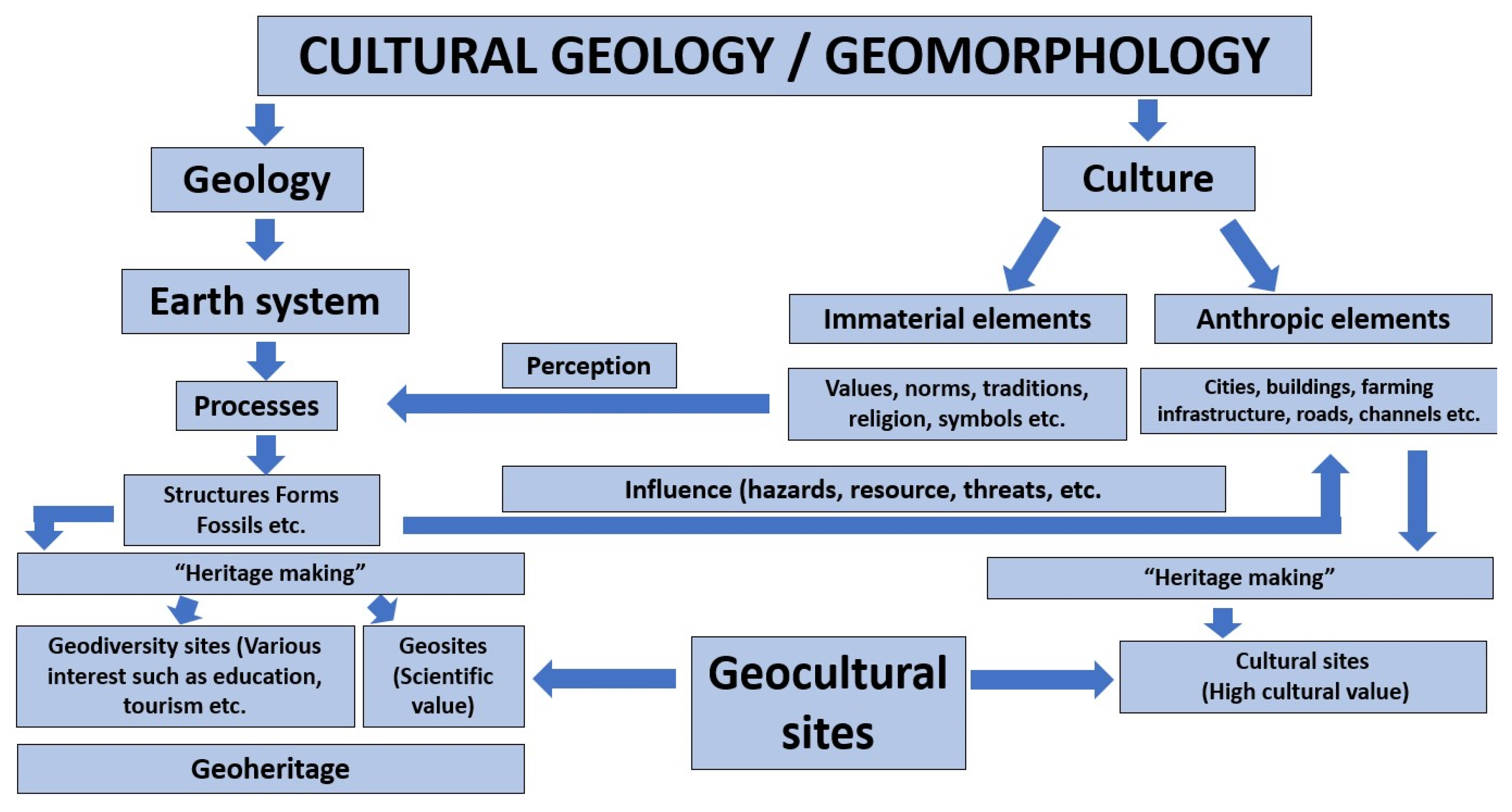

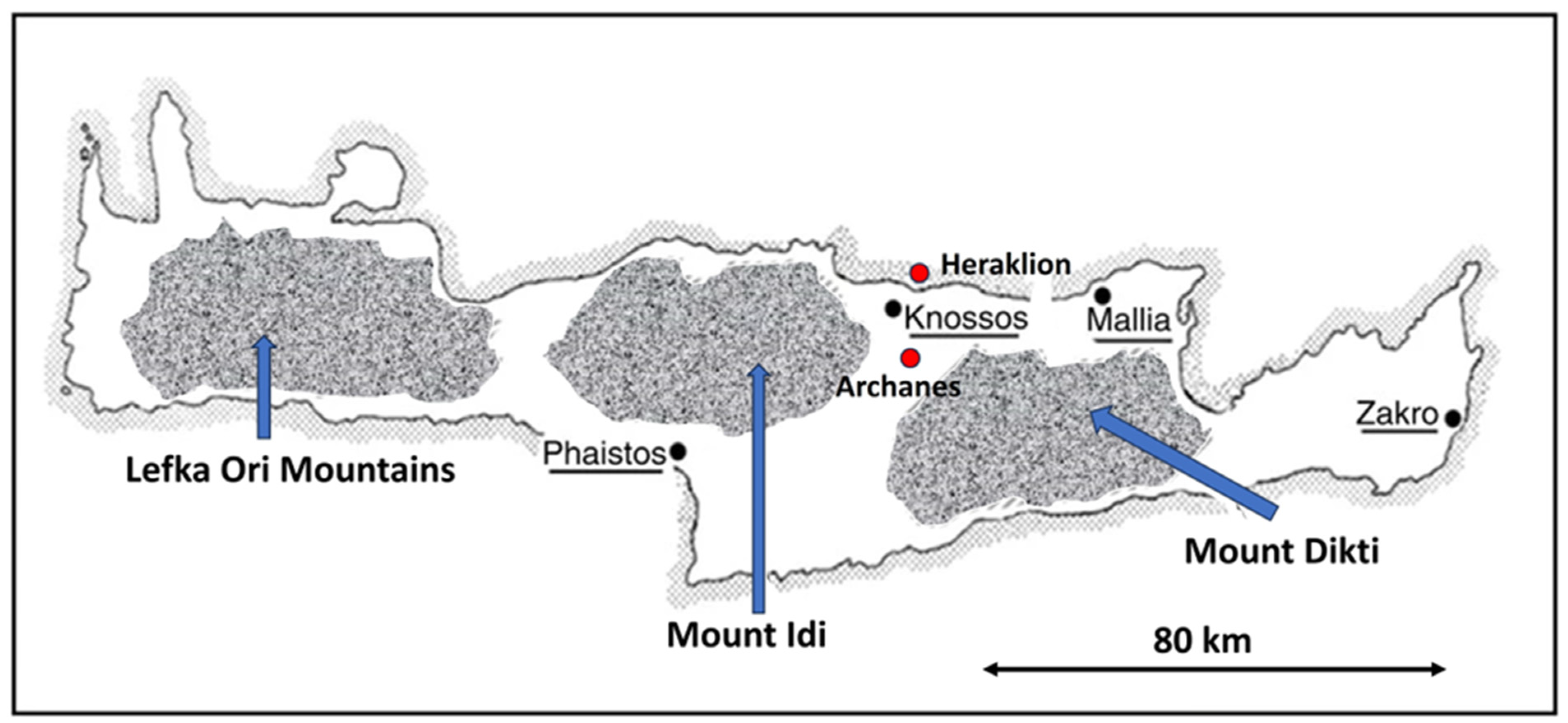
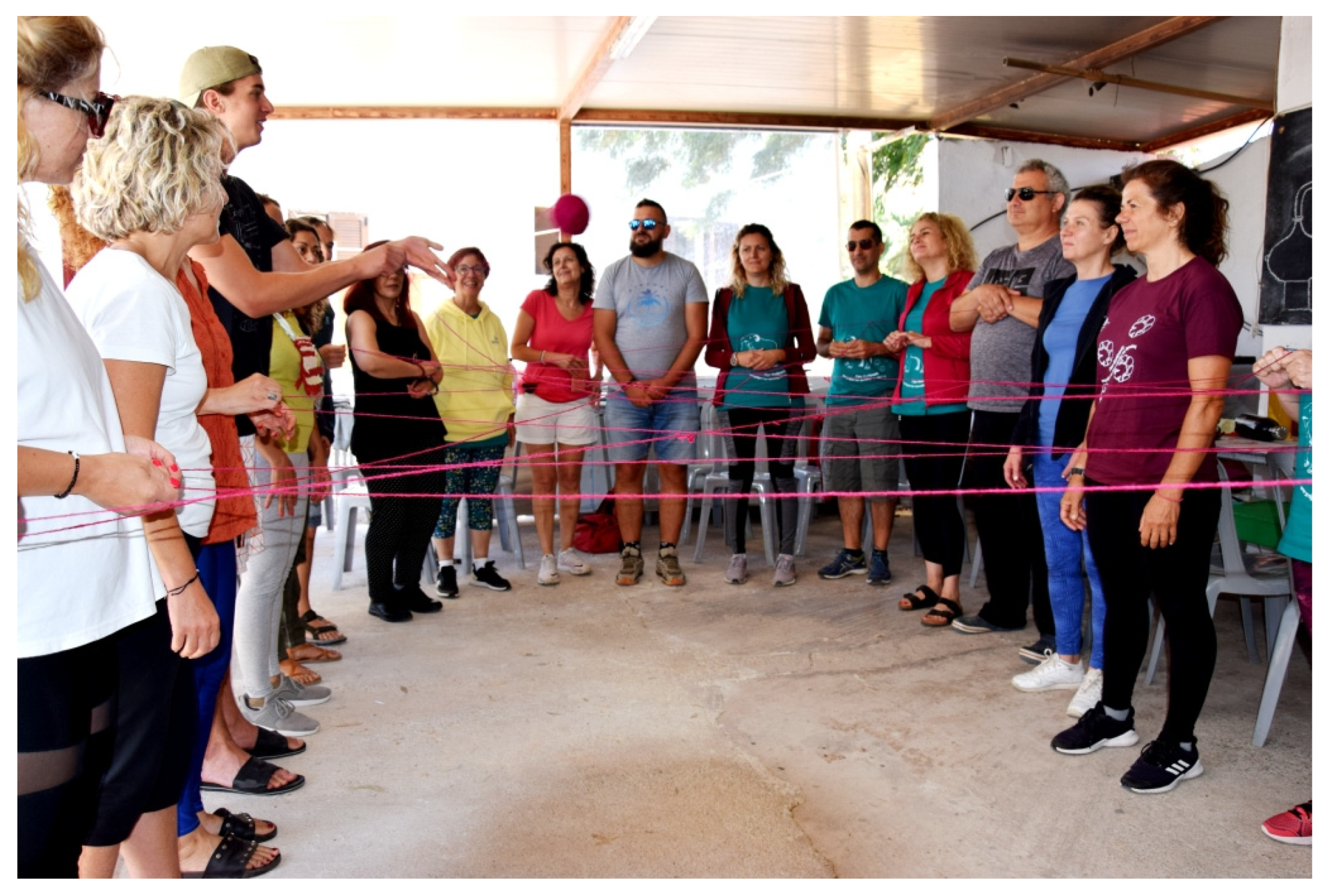

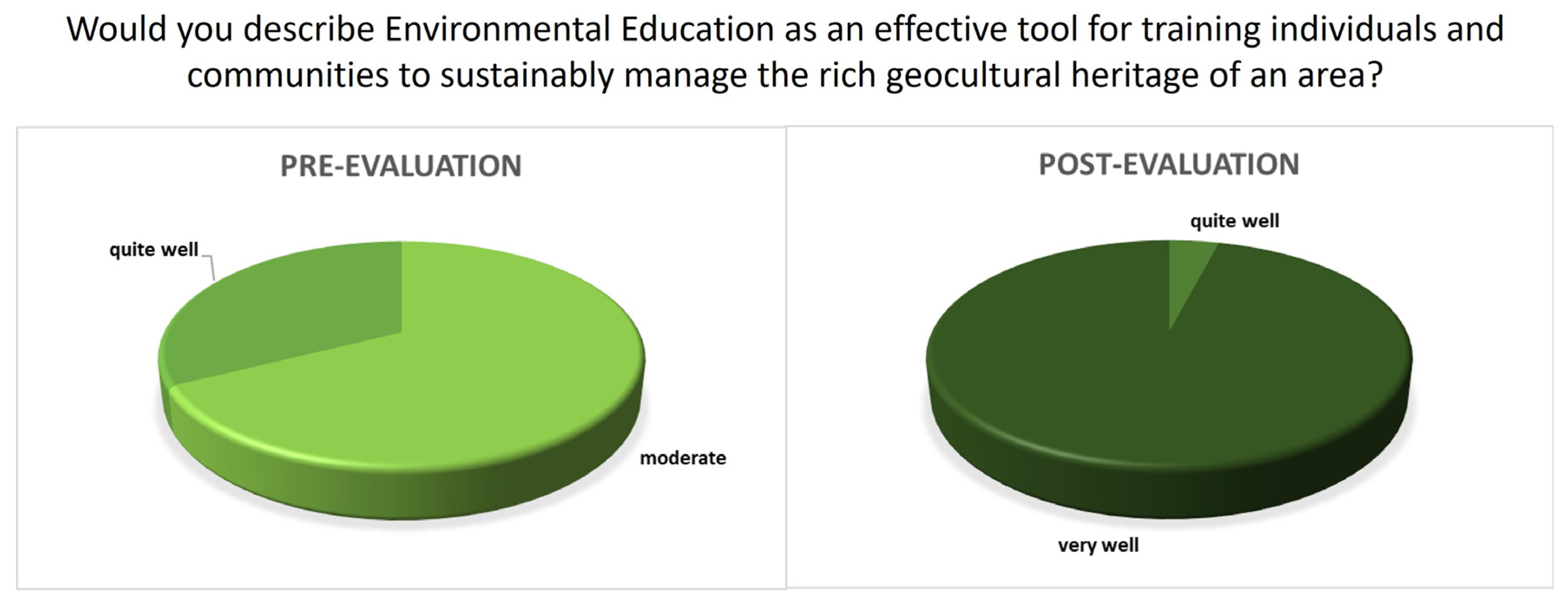
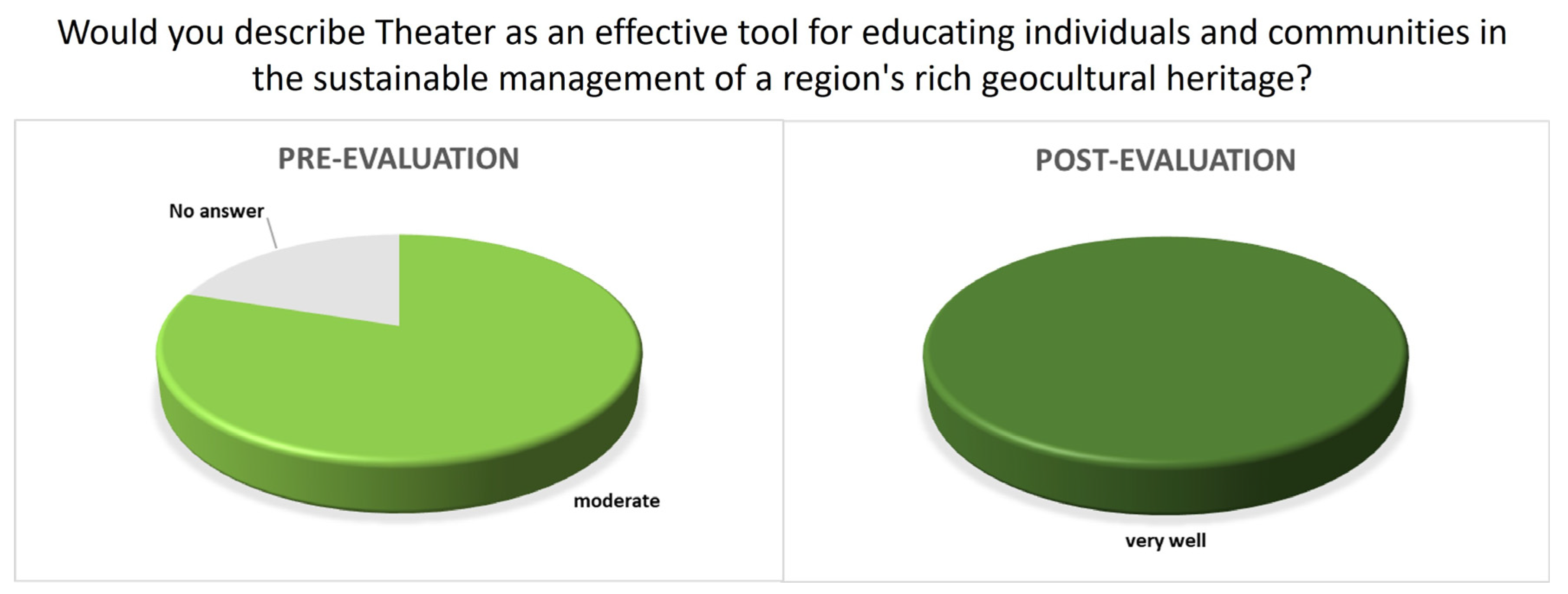
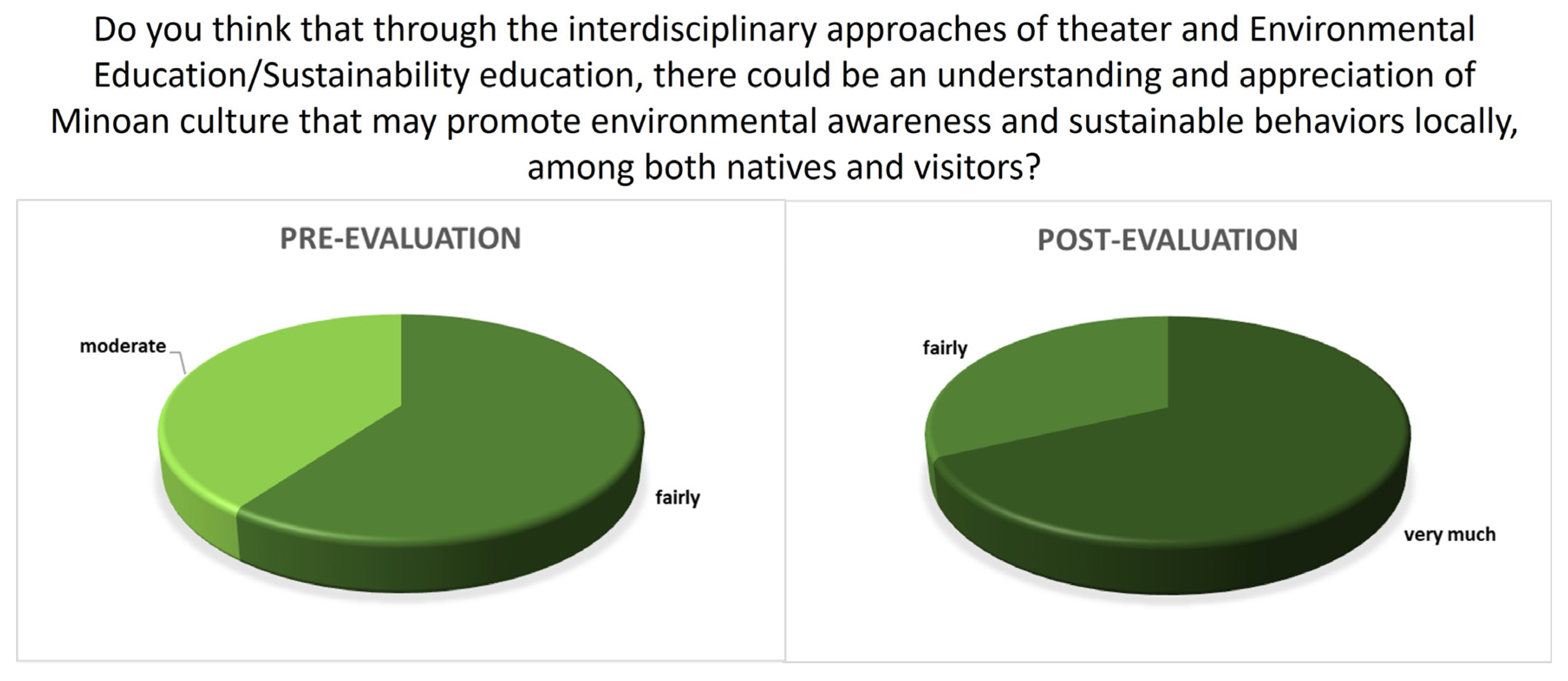
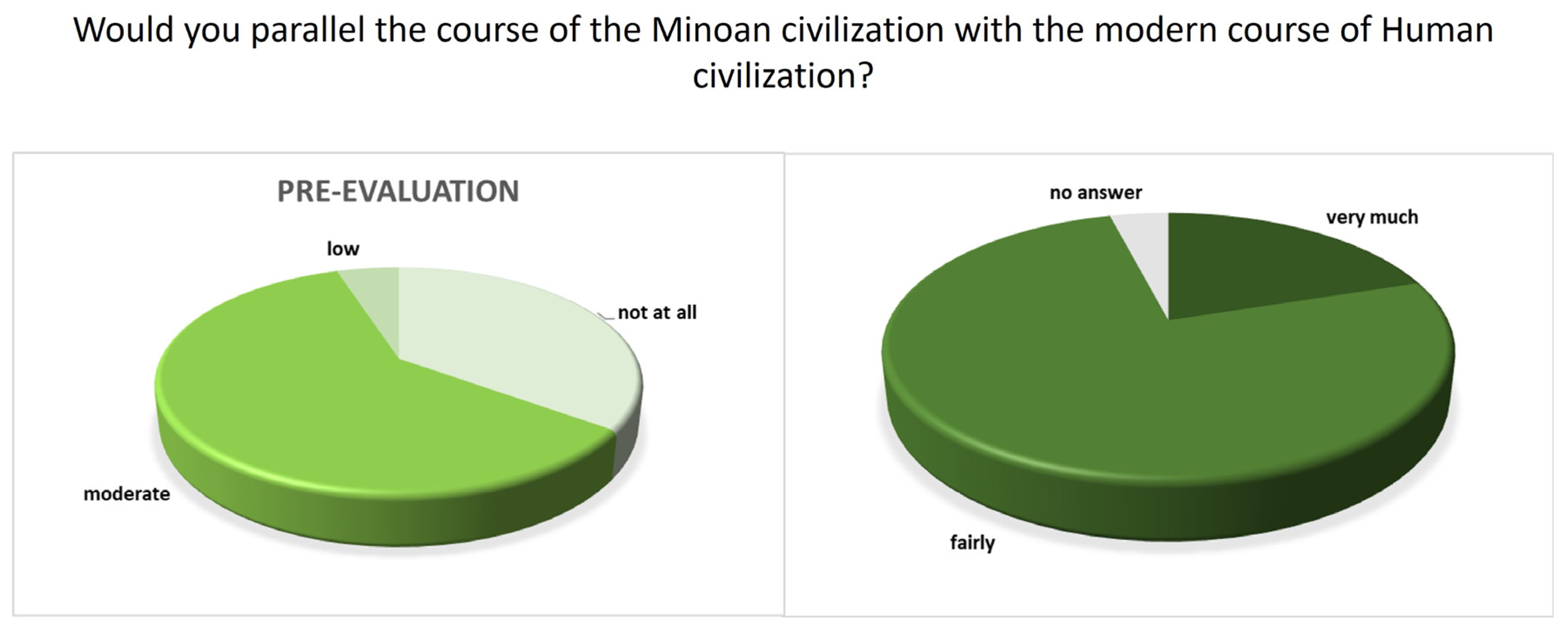
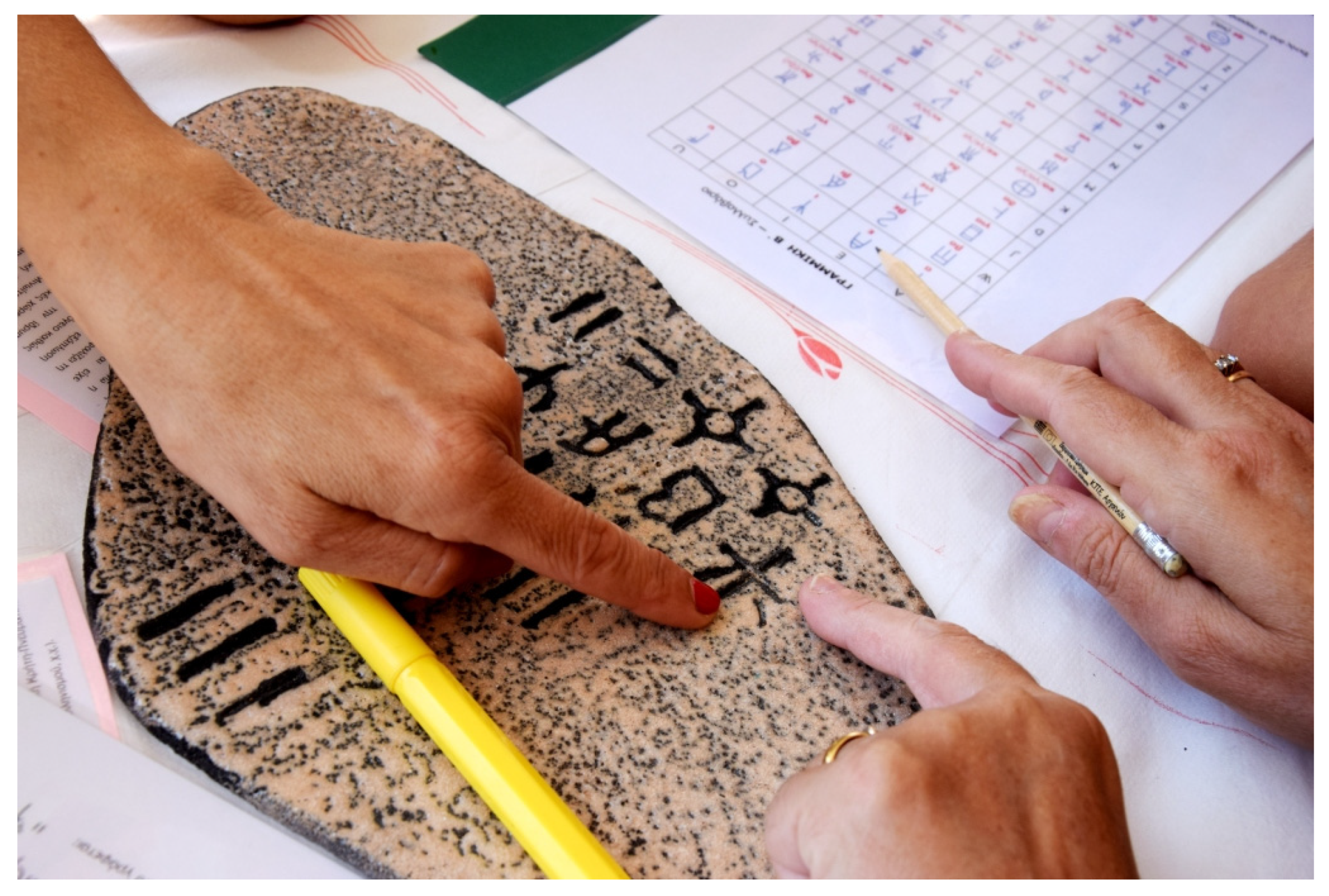
Disclaimer/Publisher’s Note: The statements, opinions and data contained in all publications are solely those of the individual author(s) and contributor(s) and not of MDPI and/or the editor(s). MDPI and/or the editor(s) disclaim responsibility for any injury to people or property resulting from any ideas, methods, instructions or products referred to in the content. |
© 2024 by the authors. Licensee MDPI, Basel, Switzerland. This article is an open access article distributed under the terms and conditions of the Creative Commons Attribution (CC BY) license (https://creativecommons.org/licenses/by/4.0/).
Share and Cite
Fanioudaki, E.; Drinia, H.; Fassoulas, C. Geocultural Interactions in Minoan Crete: An Environmental Education Perspective through Drama Techniques. Sustainability 2024, 16, 907. https://doi.org/10.3390/su16020907
Fanioudaki E, Drinia H, Fassoulas C. Geocultural Interactions in Minoan Crete: An Environmental Education Perspective through Drama Techniques. Sustainability. 2024; 16(2):907. https://doi.org/10.3390/su16020907
Chicago/Turabian StyleFanioudaki, Elena, Hara Drinia, and Charalampos Fassoulas. 2024. "Geocultural Interactions in Minoan Crete: An Environmental Education Perspective through Drama Techniques" Sustainability 16, no. 2: 907. https://doi.org/10.3390/su16020907
APA StyleFanioudaki, E., Drinia, H., & Fassoulas, C. (2024). Geocultural Interactions in Minoan Crete: An Environmental Education Perspective through Drama Techniques. Sustainability, 16(2), 907. https://doi.org/10.3390/su16020907







